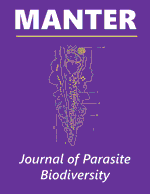Parasitology, Harold W. Manter Laboratory of

MANTER: Journal of Parasite Biodiversity
Date of this Version
Winter 5-20-2024
Document Type
Article
Citation
MANTER: Journal of Parasite Biodiversity (May 20, 2024) number 35
doi: 10.32873/unl.dc.manter35
Abstract
This review was crafted to clear up some of the current confusion regarding the correct taxonomic placement of those apicomplexan coccidians that produce unique monosporocystic octosporozoic (1 sporocyst with 8 sporozoites) oocysts during the sexual phase of their life history in vertebrate hosts. Currently, such oocysts have been placed in 1 of 4 genera, Avispora, Caryospora, Karyospora, or Eumonospora, 2 of which are no longer accepted or useful (Avispora and Karyospora). My review suggests that to present (2023) there are 62 valid Caryospora and 26 valid Eumonospora species. Caryospora species are recorded from a bird (1), lizards (4), snakes (56), and a turtle (1), and Eumonospora species are recorded from birds (25) and a mammal (1). In addition to the morphotypes with (more-or-less) valid binomials in both genera, there are an additional 24 Caryospora-like forms mentioned in the literature that do not yet have sufficient structural or genetic information to have merited a binomial and, therefore, must be designated as species inquirendae; these include 5 in birds, 2 in lizards, 1 in a mammal, and 16 in snakes. Similarly, 4 Eumonospora morphotypes in birds and 1 in a mammal also must be designated species inquirendae. Vertebrate hosts reported to have been infected with 1 or more species of these 2 genera include: birds: 14 families, 23 genera, 40 species; lizards: 3 families, 3 genera, 4 species; mammals: 2 families, 2 genera, 2 species; snakes: 10 families, 54 genera, 83 species; and turtles: 1 family, 1 genus, 1 species. Finally, such infections occur worldwide and have been documented in vertebrates in 43 countries on 6 of 7 continents on Earth (except Antarctica).


Comments
Copyright © 2024, Duszynski
License: CC BY-NC-SA 4.0 International